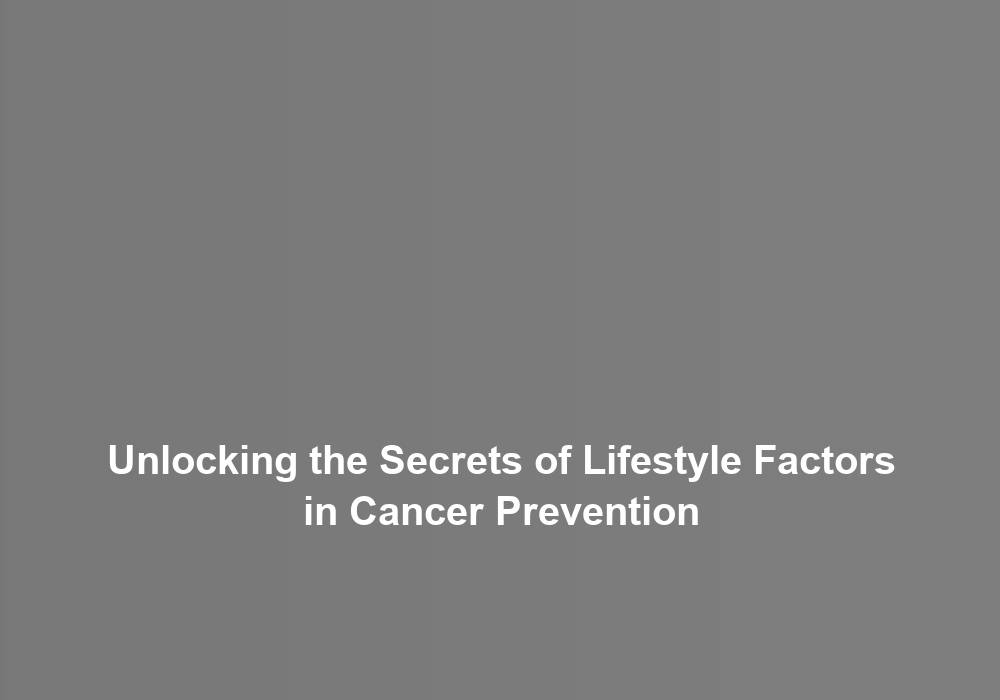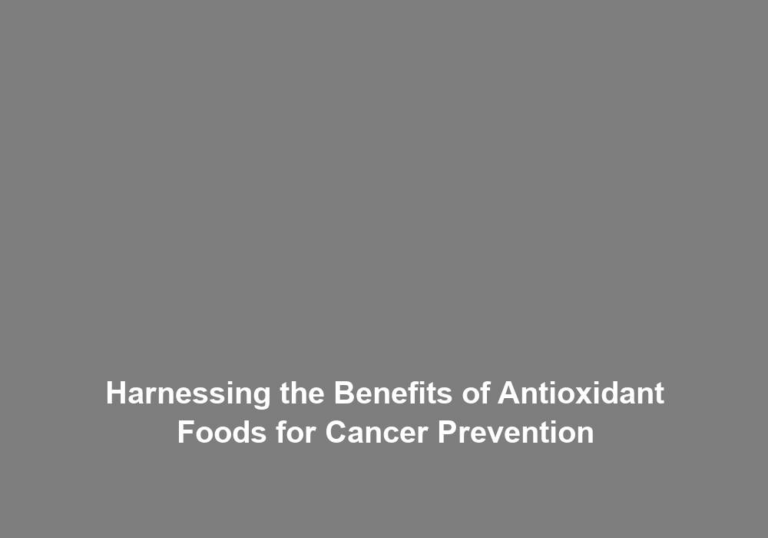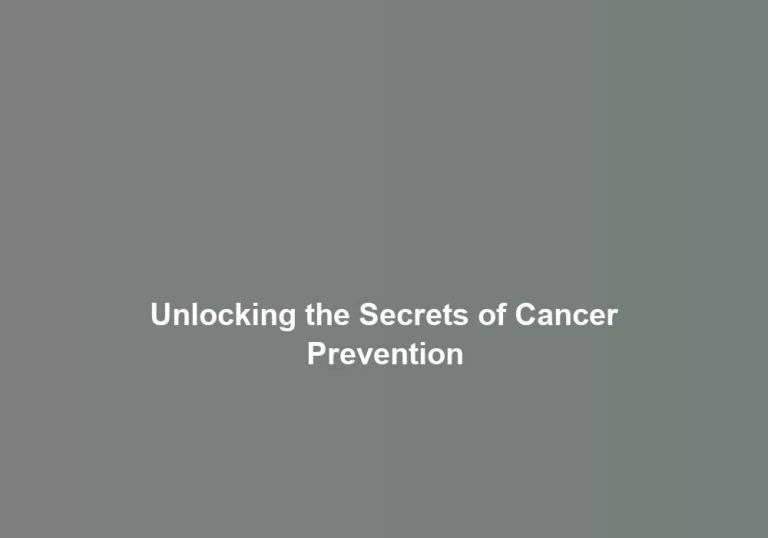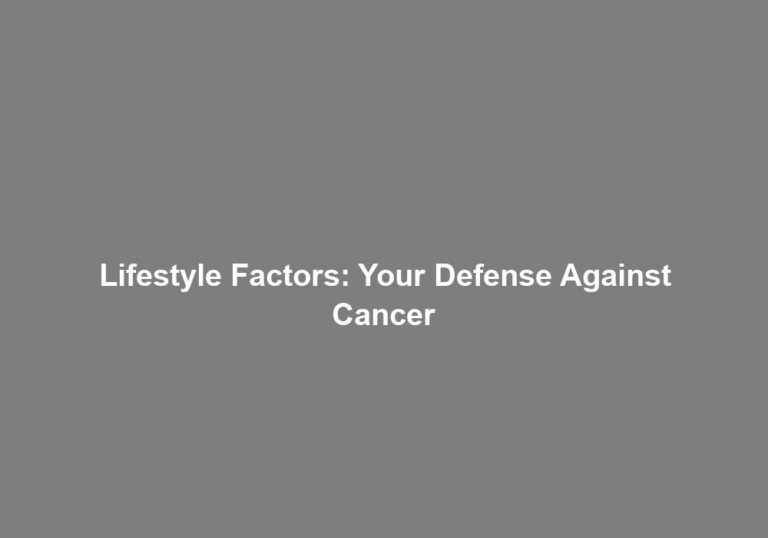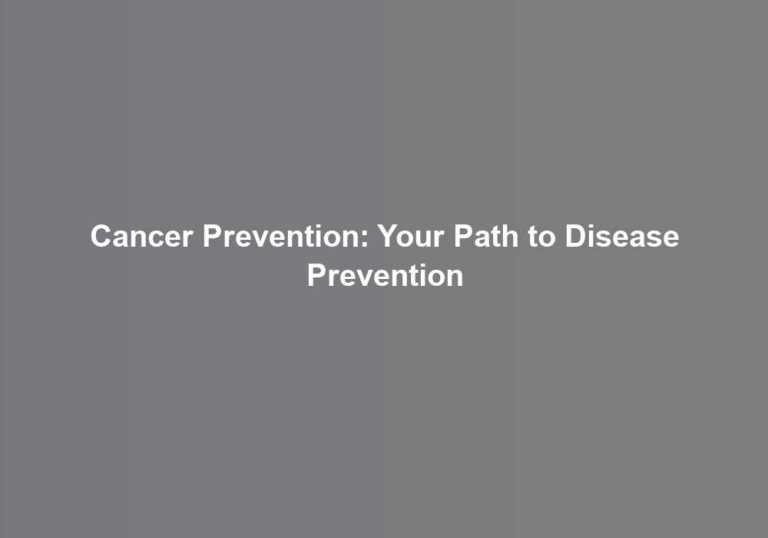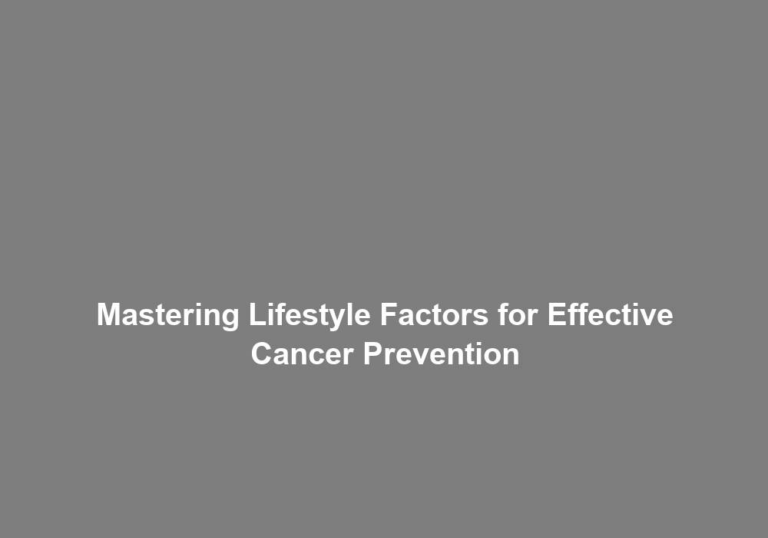Unlocking the Secrets of Lifestyle Factors in Cancer Prevention
In the vast landscape of cancer prevention, lifestyle factors serve as the compass guiding your journey toward a healthier, resilient future. While the path may seem complex, the intertwining of diet, exercise, environmental influences, stress management, and substance use holds the key to unlocking the secrets of cancer prevention. As you navigate through the intricate web of lifestyle choices, you may find yourself on the brink of discoveries that could redefine your understanding of cancer prevention, offering you a chance to take control of your health in ways you never imagined.
The Impact of Diet on Cancer Risk
A balanced and nutritious diet plays a crucial role in reducing the risk of developing cancer. Scientific evidence overwhelmingly supports the link between nutrition and cancer, emphasizing the impact of dietary choices on cancer prevention. Research suggests that certain dietary patterns, such as consuming a variety of fruits, vegetables, whole grains, and lean proteins, can substantially lower the risk of developing various types of cancer. Conversely, a diet high in processed foods, sugary beverages, and red or processed meats is associated with an increased cancer risk.
Specific nutrients found in various foods have been identified as having protective effects against cancer. For instance, antioxidants present in colorful fruits and vegetables help combat free radicals, which can otherwise damage cells and lead to cancer development. Additionally, fiber from whole grains, legumes, and vegetables plays a vital role in maintaining a healthy digestive system, reducing the risk of colorectal cancer. Omega-3 fatty acids, commonly found in fatty fish, contribute to reducing inflammation and may help lower the risk of certain cancers.
Understanding the impact of dietary choices on cancer risk empowers individuals to make informed decisions about their eating habits. By prioritizing a diet rich in plant-based foods, limiting processed and high-fat foods, and moderating alcohol consumption, individuals can actively reduce their risk of developing cancer. This evidence-based approach to nutrition not only fosters a sense of belonging to a community focused on health and well-being but also empowers individuals to take control of their health outcomes through their dietary choices.
Exercise and Its Role in Prevention
You may be aware that exercise plays a significant role in cancer prevention. Research has shown that regular physical activity can lower the risk of certain cancers, including breast, colon, and endometrial cancers. Different types of exercises, such as aerobic, strength training, and flexibility exercises, contribute to reducing cancer risk and improving overall health.
Exercise and Cancer Risk
Regular physical activity has been consistently linked to a reduced risk of developing various types of cancer. Exercise intensity plays a crucial role in cancer risk reduction. Higher intensity activities, such as running or swimming, have shown greater benefits in lowering cancer risk compared to lower intensity activities like walking. This is due to the more pronounced impact on factors such as hormone levels, immune function, and inflammation. Furthermore, exercise frequency is also a significant factor in cancer prevention. Engaging in physical activity on a regular basis, rather than sporadically, has been associated with a lower risk of developing cancer. The cumulative impact of consistent exercise on various physiological processes contributes to its preventive effects. Therefore, maintaining a routine of regular, high-intensity physical activity can significantly reduce the risk of developing cancer.
Types of Exercise
Engaging in various types of high-intensity exercises has been shown to play a significant role in reducing the risk of developing cancer. When it comes to exercise, consider the following:
- Aerobic Exercise: This type of exercise, such as running, swimming, or cycling, increases oxygen consumption and helps in maintaining a healthy weight, reducing inflammation, and improving immune functionG??all of which are linked to lower cancer risk.
- Strength Training: Incorporating strength training into your exercise routine not only helps in building muscle and bone strength but also aids in weight management and reducing insulin resistance, both of which are associated with a decreased risk of certain cancers.
- Interval Training: This form of exercise involves alternating between high-intensity bursts of activity and periods of lower-intensity exercise, and has been shown to have significant benefits in cancer prevention.
Recommended Exercise Guidelines
To achieve optimal cancer prevention benefits, it is essential to adhere to recommended exercise guidelines supported by scientific evidence and research. Regular physical activity has been consistently linked to a reduced risk of various types of cancer, including breast, colon, endometrial, and lung cancer. The American Cancer Society recommends at least 150 minutes of moderate-intensity or 75 minutes of vigorous-intensity exercise each week, along with muscle-strengthening activities at least two days per week. Engaging in aerobic exercises such as brisk walking, cycling, or swimming can significantly contribute to lowering cancer risk. Additionally, incorporating resistance training, yoga, or Pilates into your routine can enhance muscular strength and flexibility, further supporting overall health and well-being. By following these recommended routines, you can harness the extensive benefits of exercise in cancer prevention.
Environmental Factors and Cancer
Exposure to environmental factors such as air pollution, radiation, and industrial chemicals has been linked to an increased risk of developing cancer. ItG??s vital to understand the impact of environmental exposure on cancer risk, particularly for individuals with a genetic predisposition. Here are some compelling insights to help you grasp the significance of environmental factors in cancer development:
-
Air Pollution: Research has shown that long-term exposure to air pollutants, including particulate matter and nitrogen dioxide, is associated with an elevated risk of lung cancer and other respiratory system malignancies. Understanding the sources of air pollution in your surroundings and taking proactive measures to minimize exposure can be crucial in reducing your cancer risk.
-
Radiation: Whether itG??s ionizing radiation from medical imaging or non-ionizing radiation from everyday devices, the potential carcinogenic effects of radiation exposure are a subject of ongoing research. Being mindful of radiation sources, adhering to safety guidelines for medical procedures, and limiting unnecessary exposure can help mitigate the associated cancer risks.
-
Industrial Chemicals: Certain industrial chemicals and pollutants have been linked to an increased risk of various cancers. Monitoring potential occupational or environmental exposures to carcinogenic substances and advocating for protective measures in relevant industries is essential for cancer prevention.
Stress Management and Cancer Prevention
Understanding the impact of stress on cancer development is a critical component in comprehending the multifactorial nature of cancer risk. Chronic stress has been linked to the dysregulation of various physiological pathways, which can contribute to the initiation and progression of cancer. Research suggests that stress can influence the immune system, inflammatory responses, and even the growth and spread of cancer cells.
Mindfulness techniques, such as meditation and deep breathing exercises, have shown promise in reducing stress levels. These practices encourage individuals to focus on the present moment, promoting relaxation and reducing the impact of stress on the body. Studies have indicated that incorporating mindfulness techniques into daily routines can lead to improvements in overall well-being and may potentially lower the risk of cancer development.
Relaxation techniques, including yoga and progressive muscle relaxation, offer additional avenues for managing stress. These methods aim to alleviate muscle tension and promote a sense of calmness, thereby counteracting the physiological effects of chronic stress. By engaging in regular relaxation practices, individuals may mitigate the potential impact of stress on cancer risk.
The Influence of Tobacco and Alcohol
You should be aware that tobacco use is a well-established risk factor for many types of cancer, including lung, mouth, throat, and bladder cancer. Evidence also suggests a strong link between alcohol consumption and an increased risk of developing cancers of the mouth, throat, esophagus, liver, and breast. It is crucial to recognize that lifestyle choices, such as smoking and excessive alcohol consumption, play a significant role in cancer prevention efforts.
Tobacco and Cancer Risk
Research consistently shows that tobacco use significantly increases the risk of developing various types of cancer, with alcohol consumption further exacerbating this risk. When it comes to tobacco and cancer risk, itG??s essential to consider the following:
- Tobacco Cessation: Quitting smoking can greatly reduce the risk of developing cancer. Encouraging tobacco cessation through support programs and resources is crucial in cancer prevention efforts.
- Secondhand Smoke Exposure: Exposure to secondhand smoke is also linked to an increased risk of cancer. Implementing policies to reduce secondhand smoke exposure in public places and workplaces is vital for overall cancer prevention.
- Alcohol Consumption: Combining tobacco use with alcohol consumption significantly amplifies the risk of developing certain cancers. Understanding the combined impact of these lifestyle factors is essential for individuals looking to reduce their cancer risk.
Understanding the impact of tobacco and alcohol on cancer risk is crucial for making informed lifestyle choices.
Alcohol and Cancer Link
The correlation between alcohol consumption and increased cancer risk has been extensively documented in scientific literature, highlighting the importance of understanding the combined influence of tobacco and alcohol on cancer development. Alcohol consumption is a significant factor in cancer prevention, with research indicating that it can lead to various types of cancer, including liver, breast, and colorectal cancer. The link between alcohol and cancer is attributed to the metabolism of alcohol in the body, which can produce carcinogenic compounds. Additionally, alcohol consumption can weaken the immune system, making the body more susceptible to cancer development. Understanding the impact of alcohol on lifestyle choices is crucial for individuals who desire to reduce their cancer risk. Therefore, making informed decisions about alcohol consumption is fundamental in cancer prevention and overall health maintenance.
Lifestyle Choices Impact
How do lifestyle choices, particularly the use of tobacco and alcohol, impact the development and prevention of cancer?
-
Tobacco Use:
-
Tobacco contains carcinogens that can directly damage DNA, leading to the development of cancer.
-
Smoking is linked to various types of cancer, including lung, throat, and mouth cancer.
-
Secondhand smoke exposure can also increase the risk of cancer in non-smokers.
-
Alcohol Consumption:
-
Excessive alcohol intake can increase the risk of developing several types of cancer, such as liver, breast, and colorectal cancer.
-
Alcohol can interfere with the bodyG??s ability to absorb essential nutrients, impacting overall health and potentially contributing to cancer development.
-
Alcohol consumption can also disrupt sleep patterns and negatively impact mental health, further influencing cancer risk.
Both tobacco use and excessive alcohol consumption have a significant impact on cancer development and prevention, affecting various aspects of physical and mental well-being.
Strategies for Cancer Prevention
To effectively reduce your risk of cancer, it is essential to adopt and maintain a healthy lifestyle that encompasses regular physical activity, a balanced diet, and avoidance of tobacco and excessive alcohol consumption. In addition to these foundational aspects of cancer prevention, focusing on mental wellness and ensuring good sleep quality also play crucial roles in reducing the risk of developing cancer.
Mental wellness is an integral component of cancer prevention. Chronic stress, anxiety, and depression can weaken the immune system and contribute to inflammation, which are factors that can increase the risk of cancer. Engaging in activities that promote mental well-being, such as mindfulness meditation, yoga, or therapy, can help reduce the impact of stress and improve overall mental health, thereby lowering the risk of cancer.
Furthermore, prioritizing sleep quality is paramount in cancer prevention. Disrupted sleep patterns and chronic sleep deprivation have been linked to an increased risk of certain types of cancer. During deep sleep, the body repairs damaged cells, and a lack of quality sleep can disrupt this crucial restorative process. Therefore, adopting good sleep hygiene practices and aiming for 7-9 hours of quality sleep each night is vital in reducing the risk of cancer.
Conclusion
In conclusion, the evidence clearly demonstrates the significant impact of lifestyle factors on cancer prevention. By maintaining a healthy diet, engaging in regular physical activity, reducing exposure to environmental toxins, managing stress, and avoiding tobacco and excessive alcohol consumption, individuals can significantly decrease their risk of developing cancer. It is essential to prioritize these strategies in order to maximize the potential for cancer prevention and overall health maintenance. The scientific evidence unequivocally supports the importance of lifestyle factors in cancer prevention.

